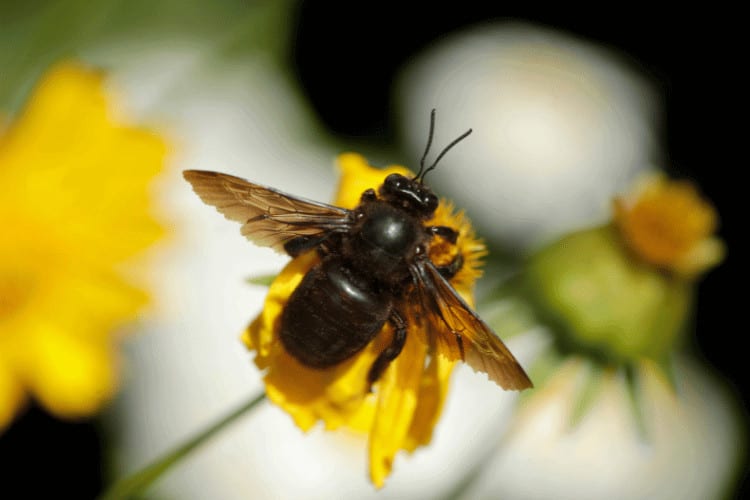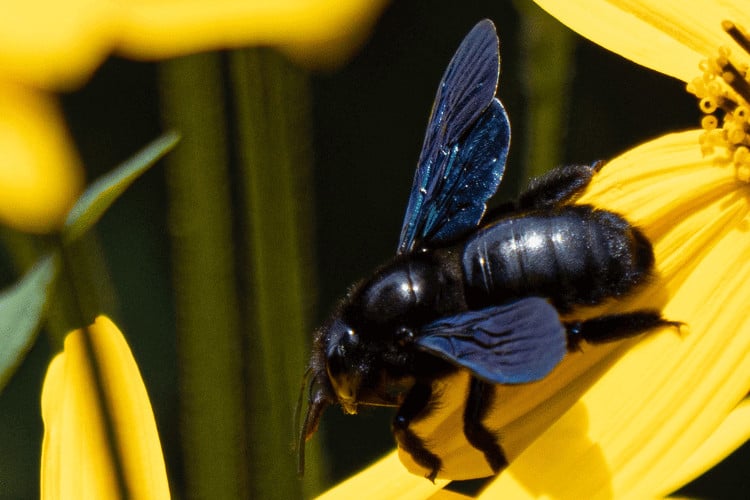Carpenter Bees vs. Mason Bees: Comparison Guide
Howdy, fellow bee enthusiasts!
If you’re anything like me, you find the world of bees utterly fascinating. There’s a buzzing world out there, and today, we’re diving into a comparison that every aspiring beekeeper should know about: carpenter bees vs. mason bees.
I’ve had my fair share of experiences with these wonderful creatures, and I’m as excited as can be to share what I’ve learned, so stick around!
Overview of Carpenter Bees: Nature’s Craftsmen

Imagine bees with a knack for woodworking; that’s the carpenter bee crew for you!
These insects are indeed remarkable creatures that bore holes into wood, making them not just excellent pollinators but also skilled carpenters.
Carpenter bees are often misconstrued as pests due to their drilling tendencies, but it’s essential to understand their role in the ecosystem.
One thing you’ll notice about carpenter bees is their shiny abdomens. It’s like they’re wearing a badge of honor, reflecting their dedication to craftsmanship.
These shiny abdomens are a hallmark of the female carpenter bees. They’re the ones doing all the drilling and crafting.
Carpenter bees are notorious for burrowing holes into various wooden surfaces. From porch railings to dead tree branches, if it’s wood, it’s fair game.
These holes aren’t random; they’re meticulously created tunnels in the wood, often unfinished and ragged on the edges. These bees prefer untreated and unpainted wood, making your old, weathered wood the ideal real estate for their nests.
Carpenter bees, despite their drilling, are actually beneficial insects. They’re efficient pollinators, buzzing from flower to flower, transferring pollen and playing a vital role in plant reproduction.
While they might sometimes give you a startle by buzzing around your head, keep in mind that they’re more interested in the flowers than in you.
Overview of Mason Bees: Nature’s Architects
Now, let’s turn our attention to the mason bees. These little architects are great pollinators, and they have a unique way of nesting that sets them apart from their carpenter bee cousins.
Mason bees, similar to their carpenter counterparts, are solitary. You won’t find massive hives or bustling colonies here. Instead, the female mason bees create their nests all on their own.
These bees use mud and other “masonry” to build partitions within their nesting holes, forming individual chambers for each of their offspring.
These pollen-packed chambers provide nourishment for the mason bee larvae as they grow. It’s like they’re packing a little lunchbox for their future selves!
Now, what’s fascinating about mason bees is that they’re often praised for being efficient pollinators. In fact, they’re often considered superior pollinators compared to the average honeybee.
The reason lies in their behavior!
You see, mason bees are known to be excellent “flower pickers.” With their fuzzy bodies, they can collect pollen with ease, and they visit a wide range of flowers, ensuring cross-pollination that leads to more fruitful gardens and orchards.
Carpenter Bees vs. Mason Bees: In-Depth Comparison
So, which of these bee species is the right fit for your beekeeping needs? The answer depends on your goals and preferences.
Let’s break it down!
Nesting Habits
Nesting habits play a significant role in determining which bee species aligns better with your surroundings and preferences.
If you have plenty of dead or unfinished wood lying around your property, you might find yourself leaning towards carpenter bees.
As mentioned earlier, these skilled artisans of the insect world have an affinity for creating holes and tunnels within wooden structures.
The idea of seeing these bees craft holes into your wooden surfaces may intrigue you, but it’s essential to ensure that you provide untreated and unpainted wood, as this is where carpenter bees feel right at home.
On the other hand, if you’re captivated by the intricacies of architectural wonders, mason bees might be your ideal partner.
Witnessing them meticulously build partitions using mud within their nesting holes showcases their unique craftsmanship.
Mason bees create individual chambers for each of their offspring, demonstrating their innate ability to provide for the future generation in a precisely partitioned manner.
Pollination Habits
When it comes to pollination, both carpenter bees and mason bees are essential contributors to maintaining a healthy ecosystem.
They ensure the cross-pollination that leads to vibrant and thriving gardens. However, there’s a distinct quality that sets mason bees apart: their active flower picking.
Carpenter bees are excellent pollinators, buzzing from one flower to another and transferring pollen effectively.
On the other hand, mason bees exhibit a unique behavior known as “flower picking.” Their fuzzy bodies allow them to collect pollen efficiently, and they visit a diverse range of flowers.
This behavior ensures they’re not just pollinating but also engaging in effective cross-pollination, which improves the productivity of your garden or orchard.
On that account, if you have a diverse range of flowering plants in your garden, mason bees can provide a crucial advantage over carpenter bees.
Social Behavior
If you’re someone who’s fascinated by the intricacies of an individual bee’s life, you’re in for a treat regardless of which species you choose. Carpenter bees tend to lead a solitary lifestyle, mirroring their counterparts, the mason bees.
Social aspects of beekeeping might be more evident when working with honeybees, but solitary beekeeping provides a unique perspective on the lives of these individual insects.
Observing the behaviors, nesting patterns, and interactions of solitary bees can be an incredibly rewarding experience.
Carpenter bees’ drilling activities and mason bees’ architectural mud work offer plenty of insights into their individual roles in their ecosystems.
Woodworking
If the thought of wooden structures with intricate holes intrigues you, carpenter bees might be the perfect bee species for you. These bees are true craftsmen, diligently drilling and creating their nests on wooden surfaces.
While not necessarily skilled woodworkers, mason bees possess a different charm that’s just as intriguing as the craftsmanship of carpenter bees, which is building nesting partitions using mud.
Observing these processes can offer a unique perspective into the skills these bees possess.
Maintenance
Both carpenter bees and mason bees are relatively low-maintenance compared to traditional honeybee hives. Their solitary lifestyles mean you won’t have to manage intricate colonies or worry about issues like queen bee dynamics.
However, your involvement in providing proper shelters and ideal nesting materials can be of great impact on their success and your satisfaction as a beekeeper.
For mason bees, constructing bee houses with small tubes or cavities that they can partition with mud is essential. Carpenter bees, on the other hand, appreciate untreated and unpainted wood blocks or logs with suitable holes for nesting.
If you’re a hands-on beekeeper who enjoys providing care and monitoring your bees, crafting suitable shelters for these solitary species can be a fulfilling endeavor.
FAQs
How long are mason bees active?
Mason bees commonly emerge during the early days of spring and remain active for about 6 to 8 weeks, spanning from around mid-April to mid-June.
Their peak activity often aligns with the blooming period of diverse fruit trees.
How long are carpenter bees active?
Carpenter bees are typically active for several weeks to a few months, with their activity usually lasting from early spring to mid-summer.
This particular time frame allows them to carry out their nesting and pollination activities during the warmer months of the year.
Are mason bees better pollinators than carpenter bees?

Mason bees’ active flower picking and diverse flower visits make them particularly effective at cross-pollination.
Carpenter bees, while consistent pollinators, might not match the cross-pollination potential of mason bees.
In Summary
Choosing between mason bees and carpenter bees ultimately depends on your preferences and the specific goals of your beekeeping venture. Both species bring unique qualities to the table, and understanding their characteristics can help you make an informed decision.
Mason bees are exceptional pollinators known for their efficiency in flower picking. They visit a variety of flowers, promoting cross-pollination and contributing to a bountiful garden or orchard harvest.
If you’re looking for a low-maintenance beekeeping experience and are interested in witnessing the architectural wonders of mud partitions within nesting holes, mason bees are your choice.
Carpenter bees, on the other hand, showcase craftsmanship with their woodworking skills. They drill holes into wood, making them a great fit if you have dead or unfinished wood structures.
These remarkable bees offer consistent pollination and are slightly less demanding in terms of maintenance. If the idea of observing bees create holes in wooden surfaces and contribute to plant reproduction intrigues you, carpenter bees could be the way to go.
Ultimately, the decision comes down to your interest in the nesting habits of each species, the level of involvement you’re comfortable with, and the type of pollination you aim to achieve.
Whether you’re captivated by mason bees’ flower picking or carpenter bees’ woodworking activities, both species play essential roles in pollination and contribute to the health of our ecosystems.
